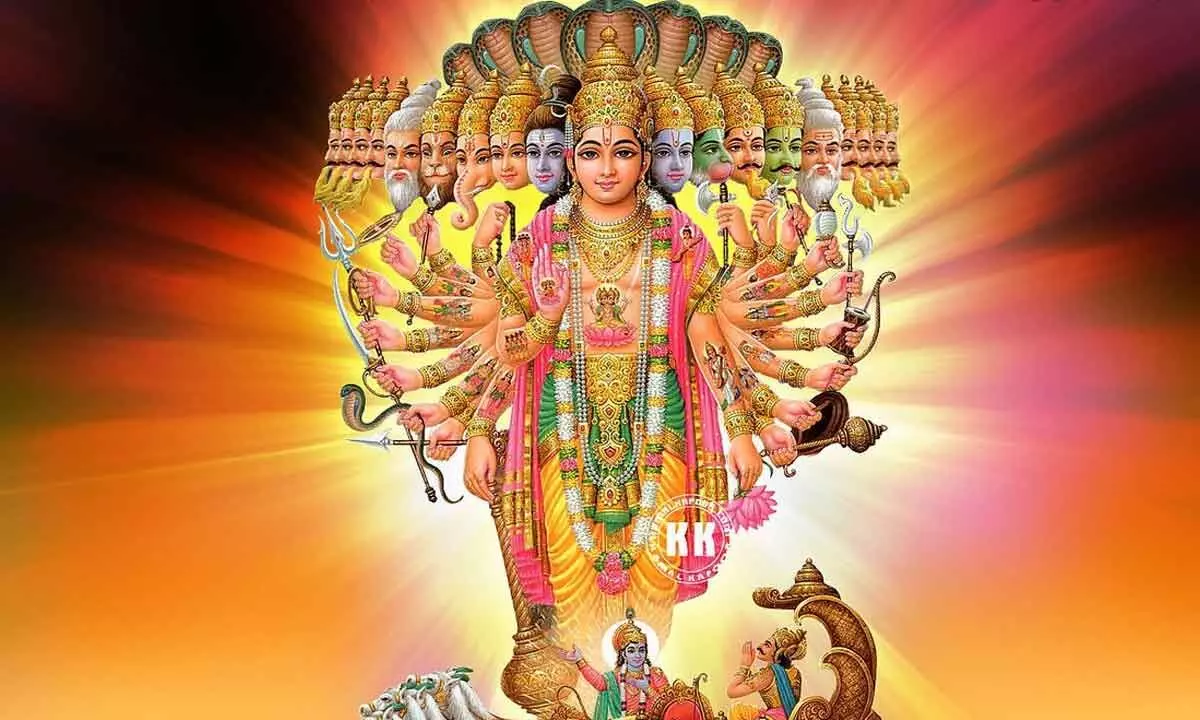Live
- Punjab seeks central assistance to strengthen security in areas adjoining Pakistan
- Malaysian national held from Tamil Nadu for cyber fraud of Rs 2.81 crore
- Child marriage will be eradicated by 2026: Assam CM
- PMK President Anbumani Ramadoss urges TN government to act against online gambling
- From defence to culture and sports, India and Kuwait sign key agreements during PM Modi's visit
- Mahakumbh 2025: 110 mist blower machines and 107 fogging units to keep Akharas insect-free
- Piyush Goyal participates in Mahila Shakti Shivir event, calls Bima Sakhi Yojana 'a revolutionary initiative'
- Death toll from Cyclone Chido in Mozambique rises to 94
- 13 criminals from two gangs arrested in Jharkhand's Ramgarh for extortion
- Union Minister Bandi Sanjay Visits Injured Boy Sritej at KIMS Hospital
Just In
Social Consciousness: The Cosmos as One Being


Perhaps the oldest version of cosmic visualisation is in the ‘Purusha Suktam’ in the Rig Veda. This is not a terrific form, but one which contemplates the whole universe as one organic entity. This is the cosmic entity, called purusha, in which all living beings originate, stay for some time, and move back into it. All heads of all beings are the heads of the purusha. All the sense organs and limbs of all beings are the organs and limbs of the purusha. My head, along with the head of a mosquito which bites me are both the heads of the same purusha. It means that the intelligence reflecting in the minds of all is the same. All beings are equal from the point of view of the purusha
Most of us are familiar with the cosmic form which Krishna shows to Arjuna in the battlefield of Mahabharata. Arjuna is terrified to see it. He sees mighty warriors like Bhishma, Drona, Karna, and others being chewed up between the fierce jaws of the cosmic being. Who is this cosmic being, wonders Arjuna. Krishna tells him that he is the cosmic scheme to destroy evil, whenever evil is in ascendency.
Krishna shows a similar type of cosmic form in the court of Duryodhana. Krishna goes as a messenger, but Duryodhana plans to imprison him. There too, it is a fierce form, showing the multitude of divine forces, with weapons in their raised hands. The evil Kaurava-s were terrified and could not see the cosmic form whereas the sages praised the form, seeing the law of nature in crushing evil when it went beyond a limit.
Perhaps the oldest version of cosmic visualisation is in the ‘Purusha Suktam’ in the Rig Veda. This is not a terrific form, but one which contemplates the whole universe as one organic entity. This is the cosmic entity, called purusha, in which all living beings originate, stay for some time, and move back into it. All heads of all beings are the heads of the purusha. All the sense organs and limbs of all beings are the organs and limbs of the purusha. My head, along with the head of a mosquito which bites me are both the heads of the same purusha. It means that the intelligence reflecting in the minds of all is the same. All beings are equal from the point of view of the purusha.
Visualising the whole universe as one organic entity can change our vision. If the whole universe is one cosmic being, where am I? I am very much a part of the same entity and so are all beings. I am an infinitesimal entity with a body-mind complex, appearing for a fleeting second in the vast eternity of time and space. This is the meditation prescribed in the famous ‘Purusha Suktam’. A mere knowledge of the cosmos can make a person an enlightened criminal. Hence the sages made it a philosophical meditation to make people behave more responsibly to all beings, and voluntarily subject to the cosmic scheme of things. This is Karma Yoga, which we discussed in an earlier article.
Science explains the cosmic form without reference to God. Scriptures describe it with reference to a cosmic intelligence which we can call God who punishes the evil and restores the good. Purusha suktam is a visualisation of cosmic form with reference to one conscious entity which indwells all beings, humans, animals, birds, and bacteria too. It is for meditation (Upasana) on oneness, to attain sarvatma-bhava, the understanding that I am one with all other beings. It is only when the whole exists that I too can exist. Such meditation is described in texts such as the Srimad Bhagavatam and the puranas. Details may slightly vary, but the broad idea remains the same.
One mantra in this wonderful meditation, ‘Purusha Suktam’, created great discontentment and frictions in the Hindu society. This is because it mashoulders; idental reference to the social structure of the day figuratively, saying that the brahmin was like the mouth of the society, the warrior was like the shoulders, the businessman was like the thighs and the labourer was like the feet of the cosmic being. In the course of time, due to ignorance of Sanskrit and of scriptures, people forgot philosophy and started using the ‘suktam’ for rituals. Thus, some people developed ideas of superiority, pushing some others to indignity. The ‘suktam’ repeatedly says that the description is a mere ‘kalpana’, a visualisation, a figurative way of putting all things in one vast picture. It is a gross misunderstanding to say that the brahmin literally came out of the mouth or that the worker literally came out of the feet. Modern teachers like Vivekananda have always been saying this. There is a great need to emphasize this.
(Writer is former DGP, Andhra Pradesh)

© 2024 Hyderabad Media House Limited/The Hans India. All rights reserved. Powered by hocalwire.com






